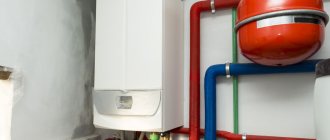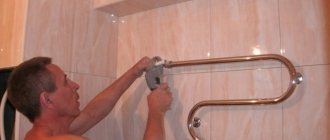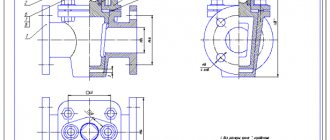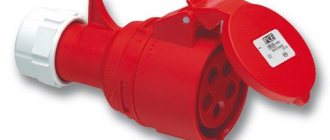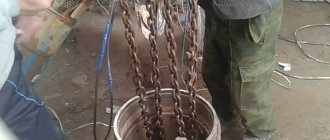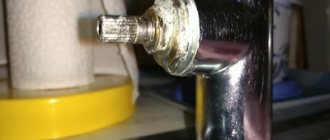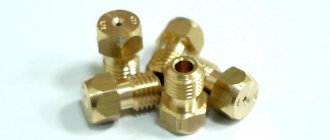One of the most important elements of water supply systems for private homes is a hydraulic accumulator. Thanks to this device, constant pressure in the water supply is maintained, and all equipment is protected from water hammer.
Membrane for hydraulic accumulator
However, nothing lasts forever, so you need to know how to replace the membrane in the accumulator - without it it will not be able to work.
Operating principle of a hydraulic accumulator
The operation of all hydraulic accumulators is based on a single principle - a membrane chamber with water, made of a polymer material, is surrounded on all sides by air pumped under a certain pressure, regulated by a special sensor.
Therefore, the liquid pressure in the membrane chamber, and therefore in the entire home plumbing system, is always stabilized by an air gap. This means:
- The home plumbing system is 100% protected from water hammer of various kinds, since it is equipped with a sensor that opens a control valve that releases excess pressure.
- In case of an unplanned power outage, the user always has a supply of 50-100 liters of water, depending on the capacity, to ensure life.
- The liquid level sensor in the container, connected to the relay for turning on the pump supplying water to the system, is configured in such a way that it turns on the water supply pump only when necessary. This, firstly, reduces energy consumption, and secondly, increases the durability of pump parts.
- The water in the accumulator tank does not come into contact with water, so replacing the metal tank will never be necessary due to its wear and tear from corrosion.
All these indicators ensure the smooth operation of the home plumbing system.
What affects wear?
The membrane is a consumable element of hydraulic accumulators, which breaks or becomes deformed during operation and requires constant and timely replacement. Manufacturers of this group of products provide a guarantee of up to 5 years for the uninterrupted operation of their products.
The rate of wear and tear of a part depends on several factors:
- pressure drops in the system;
- constant compression and straightening;
- continuous friction process;
- constant and sudden changes in temperature;
- increased level of pressure.
For uninterrupted operation of the system, experts recommend checking it every 6 months, and, if necessary, replacing parts once a year.
Signs of membrane damage:
- changes in water pressure;
- chaotic movement of the needle on the pressure measuring device.
Checking and diagnosing hydraulic tank problems
Let's start with the fact that the normal functionality of the entire plumbing system largely depends on the operation of the hydraulic accumulator. And if the water supply fails, then you are obliged to find the cause as soon as possible and make quality repairs. Otherwise, this can lead to more serious breakdowns, which, in turn, will inevitably lead to the failure of all equipment. And the most common reason is the membrane for the accumulator.
Let's look at how to find out, how to diagnose and replace this element.
As a rule, all problems can be easily fixed with your own hands. Let's get acquainted with the main “symptoms” and what needs to be done in a particular situation.
The pump malfunctions and turns on/off frequently
Most likely the membrane has failed. To diagnose this malfunction, disconnect the hydraulic tank from the water supply system, and then start draining the liquid. If air escapes during this, it means that there is mechanical damage to the membrane. The problem can be solved by replacing the failed membrane with a new one.
Water leaks from nipple
This is also evidence of membrane failure. The diagnostics in this case are the same, but replacing the damaged element can solve the problem.
Water pressure is weak
In this case, there are two possible reasons: failure of the pump or incorrectly selected volume of the accumulator. In the first case, the problem is solved by installing a new pump, and in the second, by carrying out calculations and replacing the product with a more suitable one.
The system pressure is too low
Everything is simple here: either the nipple is broken, or there is simply no compressed air in the container. Therefore, to solve the problem it is necessary to replace the nipple or pump up the pressure to the required level.
Water is leaking from under the flange
The reason, apparently, is a violation of the tightness of the connections. You just need to tighten the fastenings or replace the worn element.
We also recommend that you familiarize yourself with some useful tips regarding hydraulic tank maintenance. They are listed below.
- Every month, inspect the device, check whether its operating parameters correspond to the standard (the latter is individual for each specific tank model).
- If the accumulator will not be used for some time, it must be kept in a dry place, taking care that it does not come into contact with any heating devices (otherwise the membrane material may dry out and collapse).
- Check to see if there are any rusty spots at the connections or on the body.
- Check the membrane to ensure its integrity approximately every six months.
- In addition, regularly check whether there are any wet surfaces or smudges on the connections.
- Finally, if you experience any device malfunctions or malfunctions, fix them immediately!
You are also probably wondering how to check the initial pressure inside the hydraulic tank? There is nothing complicated here - just follow the instructions.
Step one. First, disconnect the accumulator from the main line.
Step two. Drain all the water from it.
Step three. Next, connect a special device to the nipple - a pressure gauge.
Step four. If the pressure gauge readings are lower than those set by default, then, using, for example, a compressor for a car, pump up the pressure to the required value.
Causes of wear
Among the factors influencing membrane wear are the following:
- temperature changes in the accumulator;
- a constant process of compression and stretching;
- friction of the membrane against the walls of the unit housing.
The membrane naturally wears out from the above factors. As a rule, the following important points indicate signs of membrane failure:
- the hydraulic accumulator began to operate jerkily;
- the pump turns on too often at short intervals;
- the pressure gauge readings suddenly reach a high level and then rapidly fall;
- the faucet seems to “spit” water.
In situations of this kind, the obvious fact is that it is necessary to replace the hydraulic tank membrane.
This is interesting: Finding water on the site with your own hands for a well or well: Secrets, step-by-step instructions
How to choose a hydraulic accumulator
First of all, you need to decide for which system you plan to use the hydraulic accumulator.
- For a device that will monitor the supply of cold water, it is necessary to proceed from the number of people living in the house and, according to the consumption rates of cold and drinking water per person, purchase a suitable hydraulic accumulator.
- The unit that supplies hot water is also purchased after calculating the hot water consumption per person per day.
- The hydraulic accumulator, which ensures uninterrupted operation of the heating system, is selected based on the area of the heated premises. Depending on this, the capacity of the hydraulic tank is selected.
It is also necessary to take into account that the operation of the entire unit is based on the use of a membrane container, which is located inside the hydraulic tank.
Selecting a hydraulic accumulator
The service life of the entire system depends on its survivability. For cold water, it is better to purchase a tank with a membrane made of isobutated rubber, the water from which is safe for use in cooking.
Next, when making a choice, you need to pay attention to the flange that secures the water supply system. Its quality affects the service life of the hydraulic accumulator
Accumulator flange
The better the quality of the flange, the longer the accumulator will work. Made from galvanized steel, stainless steel or composite plastic.
Calculation of the optimal volume of the hydraulic tank
There is no GOST standard for the volume of a hydraulic tank. Everyone chooses a container for using water individually. You need to start from two parameters.
Hydraulic tank dimensions
- The size of the utility room where at least one hydraulic tank will be installed. For example, the size of a 100 liter tank is a barrel standing vertically, about 850 mm high, and 450 mm in diameter.
- Next, you need to calculate the amount of water consumed by each family member (approximately). Also, take into account the water consumption when doing laundry, washing dishes and other household needs. In any case, even if an error was made in the calculations, you can always replace the tank and increase its capacity.
Kinds
A membrane tank is a special container in which a certain amount of water accumulates. The main function of the expansion membrane tank is to collect water and supply it under a set pressure.
Manufacturers produce several types of rubber membranes:
- pear;
- ball;
Small types of membranes up to 100 L are similar to a rubber heating pad or glass jar. Models with a volume of more than 100 liters resemble a pear or bottle.
On the shelves of specialized stores you can purchase two types of expansion membrane devices:
- with a replaceable membrane - has a high price, it is possible to timely replace the part if ruptures and deformation occur;
- with a stationary membrane - has a low price range, there is no possibility of replacing damaged elements and restoring the operation of the water supply system.
Modern manufacturers produce a wide range of membranes for hydraulic accumulators, the volume of which starts from 10 liters. For home water supply systems, the most popular tanks are 24, 50, 60 and 80 liters. In residential cottages with a large number of people, membranes with a volume of 100, 150 and 300 liters are installed.
For uninterrupted operation of heating systems in rooms of various types and purposes, experts recommend installing Wester expansion tanks , which monitor the pressure in the pipes and, if necessary, automatically reduce it to an acceptable level.
Material
One of the main criteria when choosing the required membrane is the type of material from which the part is made. Due to the fact that the rubber element is in constant contact with water, the material from which the membrane is made must comply with all sanitary standards and requirements.
Modern manufacturers offer five types of material:
- natural rubber;
- artificial butyl rubber;
- artificial material EPDM;
- material for heating systems type SBR;
- Nitril type material for oil and flammable substances.
For systems with process water, it is possible to use membranes made of any type of material.
Characteristics
The technical characteristics and properties of membranes depend on the type of systems in which they will be used. Manufacturers produce membranes for heating and water supply systems.
Technical features of membranes for water supply systems:
- withstand pressure up to 7 bar;
- operated in a temperature range from 0 degrees to 70 degrees above zero;
- the base is natural rubber, which has high environmental performance and resistance to the formation of microorganisms;
- White color.
Characteristics and properties of membranes for heating systems:
- base – special rubber;
- has a wide temperature range from -10 degrees to +100 degrees;
- withstands pressure up to 8 bar;
- black color.
Design and principle of operation
The peculiarity of hydraulic tanks is that the water does not come into direct contact with the metal body, but remains enclosed in an elastic cavity, also called a membrane. The membrane is made of butyl, a durable rubber material. Butyl provides the proper level of protection of water from bacteria, which metal cannot boast of.
There is an air gap between the elastic membrane and the metal body. Nitrogen is pumped into it, but the chamber can also be filled with ordinary air. The chamber is equipped with a special pneumatic valve, through which the pressure inside is regulated. You can fill the chamber through this valve or, conversely, bleed the air.
The hydraulic accumulator installation can be disassembled and reassembled at any time. It has a simple device. This simplicity is ensured so that it is always possible to identify problems and carry out timely repairs. In this case, the device can be repaired without pouring all the water out of it.
Large-volume hydraulic accumulators have an additional valve in the membrane, which also allows air to be released, but here we are talking about air that is released from the water. Small hydraulic tanks do not have this function, but then the valve must be on the pipeline.
The hydraulic accumulator operates as follows.
- First, water is pumped into the elastic cavity, stretching and filling it. A special relay is attached to the cavity.
- Once the pressure threshold is reached, the relay reacts to this and turns off the pump.
- Further, during operation of the accumulator, the pressure drops again, and the relay, reacting to this, turns on the water again. The relay can be set to any level. This type of device is called an automatic hydraulic accumulator.
Nowadays, such options are practically not found, but there are still outdated hydraulic tanks, the level of filling of which must be monitored and filled independently as needed.
Peculiarities
To reduce energy consumption and eliminate pressure level fluctuations in modern pumps with hydraulic accumulators, manufacturers install a special separating element - a membrane.
The shape of the membrane part depends on the volume of the container and comes in two varieties:
- oblong;
- elongated.
The base is rubber or specialized rubber. The material for the manufacture of the membrane must comply with all hygiene standards and sanitary standards. Special rubber that is resistant to mold and mildew can withstand high pressure and a wide temperature range.
Manufacturers produce two types of membranes:
- flat;
- balloon
Different types of membranes perform the same functions and have no technical differences.
Device
The hydraulic accumulator membrane is an element that allows the hydraulic accumulator to be divided into an air section and a water section. An elastic membrane is placed in the tank body, forming two spaces that are independent of each other.
The balloon membrane device is filled with water, and in the cavity between its walls and the accumulator shell there is air pumped under high pressure. A flat membrane is attached to the walls of the battery, forming two isolated spaces.
With the help of alluvial systems, water is pumped into the device until the maximum pressure level is formed. Experts set the required level using a relay on the equipment body.
Principle of operation
The principle of operation of the accumulator is to supply water to the membrane by a pump. In the cavity between the walls of the membrane and the coating of the accumulator, the pressure necessary for the operation of the entire water supply system is created.
When the value set on the relay is reached, the pumping system automatically turns off, maintaining internal pressure. This allows you to avoid changes in water pressure and ensure stable operation of the system. After the pressure drops to a minimum level, the pumping unit will automatically begin drawing water and pumping air again.
What causes the failures?
If the pump cannot lift water, external factors often contribute to this:
External malfunctions in the pump.
- A decrease in the fluid level in a hydraulic structure; in this case, the unit initially pumps water poorly, and soon ceases to perform its function, running idle. At the same time, the wear of the device increases, it quickly fails, since there is no provision for dry operation.
- The depth of the hydraulic structure is insufficiently large (up to 8 m), this becomes a cause of failure if the groundwater level decreases. With small well sizes, such changes are more noticeable.
- If you plan to install a pumping station on the site, it is possible to install a filter element. It is located at the inlet of the system - attached to the supply pipe at the bottom of the hydraulic structure and is constantly in contact with contaminants (sand, lime, substances contained in water). If you do not clean the filter, the water will stop rising.
The power of the electric motor was insufficient
If the force of the created water pressure was small initially, there is a high probability that the equipment was selected incorrectly due to an erroneous calculation of its power. As a result, the pumping station becomes ineffective: water is often absent or supplied intermittently.
When calculating the power of a device, a reserve is always made (10-15%), which will compensate for errors and the impact of negative factors during operation. If these nuances have not been taken into account, the unit operates at the limit of its capabilities: it often turns on and off or operates continuously, which leads to rapid wear and malfunctions. At best, the device requires repair, and at worst, it fails.
The power of the pump electric motor may be insufficient even if the unit is operated for a long time. This occurs when the configuration of the pipeline changes: its length or diameter increases, the direction changes due to the transfer of some plumbing fixtures, the restructuring of the facility and its redevelopment.
Low electric motor power.
Another reason for the pressure drop due to the low power of the device is an increase in the depth of the well. Each type of pump is designed for operation under specified conditions. If the source data changes, you should select a different unit option.
Elements of the pump discharge mechanism are worn out
Depending on the type of device, different components may fail: impeller, membrane. These structural elements often operate at high speeds and are therefore subject to high loads, which leads to rapid wear. If water with sand impurities rises from the bottom of the well or other contaminants are present in it, this can accelerate the wear of parts.
If the pressure weakens for no apparent reason (the water level in the well is normal, the power is sufficient, voltage drops in the network are not observed), it can be assumed that the pump has failed. If the pump is cheap, then it is often impractical to carry out repairs, since its cost can be high.
The pipeline leaked
The pipeline leaked.
- communication defect;
- exceeding the permissible pressure in the pipes, for example, if they are of small cross-section and the pump is powerful;
- if a leak has formed in the area of the threaded connection, the reason may be a lack of sealing material;
- The check valve is clogged, preventing it from closing.
Repairing the diaphragm
Repair of the accumulator membrane is possible if the damage is minor. This is especially true in units with non-removable diaphragms. After all, if a rubber part wears out, the entire device will have to be replaced.
A very tiny crack is sealed using a rubber adhesive.
You can repair the part yourself using a vulcanizer for bicycle or car inner tubes. A similar problem is addressed to the tire shop. Before installing the repaired diaphragm, you need to carefully check the internal surface of the drive. Protrusions and burrs are not allowed.
Repair work will extend the life of the membrane, but not for long, on average by six months. After that you will still have to buy a new one.
Replacing the membrane
If the cause has already been determined, then repairs need to begin. And the first thing you need to do is purchase a new product
Here it is important not to save money and buy original spare parts, because... cheap fakes can quickly fail
And the situation will turn out to be that in six months you will have to do everything again.
Preparation
When a new membrane has been purchased, you need to prepare a set of keys and proceed to the repair. First, you need to drain the water from the container itself. For this:
- the water supply to the hydraulic accumulator is cut off;
- the air is vented from it;
- water is drained.
An important point is that if air comes out of the battery when water is drained, it means that the rubber bulb is damaged. The nipple also swings in the same way - if water comes out when bleeding air, this indicates a breakdown.
The fact is that the bulb divides the inside of the tank into two independent chambers. Therefore, mixing of water and air is excluded. If this happens, then the internal integrity is broken.
Repair stages
When the water from the tank is drained, you can proceed directly to the repair. Replacing the membrane in a hydraulic accumulator is done as follows:
- first, you need to remove the flange; to do this, unscrew the nuts holding it with a wrench;
- after this, the old membrane is taken out;
We take out the old membrane - it must be carefully examined and the place of damage must be found.
Firstly, this will make sure that it is torn, and secondly, you need to assess the extent of the damage. After all, if they are small, you can try to vulcanize it; Checking where the membrane has broken - Now it is advisable to inspect the inside of the tank - most likely there will be dirt and rust in it. Therefore, it needs to be cleaned well;
- after this, you need to carefully inspect the flange - there should be no damage or burrs on it. If there are any peelings, they are smoothed out with sandpaper. The same applies to the seat - it needs to be thoroughly cleaned;
- now you need to take a new membrane, straighten it and insert it in place of the old one;
- after that, it is covered with a flange and it is tightened with nuts.
This completes the replacement process. Now, you need to do a test run of the hydraulic accumulator. To do this, it is connected back to the water supply. But at the beginning, you need to pump air into it to operating pressure, which is 1.5-2 atmospheres.
And then the water supply is turned on. At the same time, you should not open the supply valve to full capacity. This can lead to rupture of the membrane, therefore, water is added gradually.
Thus, changing the membrane with your own hands is quite simple. And this can be dealt with without any problems without involving specialists. Moreover, the cost of replacement in a specialized center can be quite high.
Prevention
To prevent a breakdown of the hydraulic accumulator from taking you by surprise, you need to carry out periodic maintenance. It's easy to do:
- once every 3-4 months the tank is inspected for damage;
- Once every six months, you need to check the operation of the pressure gauge, pressure switch, and also check the air pressure level in the tank.
In addition, all experts recommend replacing the membrane in the accumulator every three years. Naturally, subject to its constant and uninterrupted use.
The fact is that the average service life of these products rarely exceeds this figure. Therefore, it is better to replace it in advance - this way you can protect yourself in advance from a sudden breakdown.
Previous articles Next articles
Setting indicators in a new membrane-type expansion tank
The device is divided into two parts, separated by a membrane. It exerts pressure on one of the halves , this is taken into account when setting up.
Most devices have factory default values, which are not always suitable for use in certain conditions.
To change the indicators, there is a nipple to which the plumber connects a compressor or hand pump.
Attention! Many pressure gauges show excess. To determine the actual pressure, add 1 atm.
The initial indicator is made equal to that obtained in the cold system by adding 0.2 atm. The sum gives the value of the static head divided by 10 . For example, in a house 8 m high:
P = 8/10 + 0.2 atm.
The values are achieved by filling the container with air through the spool.
Incorrect calculations can lead to one of two problems:
- Tank overflow. Sometimes the air cavity exhibits a value twice the static pressure. Turning on the pump will lead to a change in the number, but not more than 1 atm. If the difference is larger, there will be a disadvantage, due to which the compensator will begin to push the coolant out of the tank. This could lead to a serious accident.
Photo 2. Pressure standards in the expansion tank: when it is empty, filled with water and when the filling of the device reaches the limit.
- Receiving an insufficient indicator . In a filled system, the working fluid will push through the membrane and fill the entire volume. Each time the heater is turned on or the pressure increases, the fuse may trip. The expander will become useless in such a situation.
Important! The initial setup must be done correctly to avoid problems. But even after the work of a good specialist, fuses may begin to trip. This is usually due to insufficient volume of the expansion tank.
To solve this you will need to purchase a new device. It must contain at least 10% of the volume of the entire harness.
Tank installation
In general, there is nothing complicated here, but when installing it, you need to take into account some nuances:
- the container must be well attached to the base. To do this, it is best to fix it with an anchor. This is necessary because the tank will vibrate during operation;
- connection to the water supply is best done through flexible hoses;
- the battery itself should be located in such a way that it is easy to maintain;
- Do not allow the electrical cable to touch the metal surface of the battery - if it breaks down, a short circuit may occur.
Installation example
Connection diagram in the general water supply system
Making a hydraulic accumulator on your own should not be particularly difficult. The main thing is to follow the basic rules - monitor the tightness of the connections and carefully connect the pressure switch. Moreover, all the work will take little time - if you don’t rush, you can get it done in one day.
Operating rules
Optimal pressure in the accumulator ensures constant water pressure and prevents wear of system parts
In order for the hydraulic tank diaphragm and the device itself to serve for a long time, you must adhere to the following recommendations:
- Inspect and test your battery monthly to ensure it meets specifications. The latter are individual for each drive model.
- If you are not using the hydraulic tank, keep it in a dry place, away from contact with heating devices. Otherwise, the diaphragm material may become dry, causing it to fail.
- Check for corrosion and leaks at the connections and on the body of the hydraulic accumulator.
- Periodically measure the air pressure in the product and monitor its stability.
- Check the integrity of the diaphragm approximately every six months.
If malfunctions occur in the operation of the device, immediate troubleshooting is required to avoid aggravation of the situation. Otherwise, you can bring the device to a state beyond repair.
When operating a pressure device with a hydraulic accumulator without a membrane, the load increases and wear accelerates. The pump constantly turns on when the tap is opened. This increases energy consumption and the risk of water hammer. A high-quality diaphragm will help protect your equipment from these troubles.
Step-by-step instruction. Different connection methods
Expanzomat is another name for an expansion membrane tank. It makes more sense if a specialist does the installation. If you decide to install it yourself, then in unclear moments, contact him and get advice. The tank can be installed both on the supply side of the line and on the return side.
Installation sequence and features:
- location of the expansion tank in space. In principle, as already mentioned, the tank can be positioned in any way you like. But from a rational point of view, the air chamber should be located at the top so as not to be affected by gravity. This will increase the already significant impact on the membrane from the coolant and air. Replacement or repair will be required after a shorter period of time than specified in the warranty;
- On the installed diagram of the heating system, select a place free from turbulence. This is usually the section of pipe in front of the recirculation pump. This is the best option;
- attach the tank to the wall and connect it to the system with a flexible hose.
It doesn’t matter where you place the tank: for supply or return, it is important that it is located at a minimum distance from the suction side of the centrifugal pump.
Why is it needed?
Practically, all coolants for heating systems are weakly compressible liquids.
Accordingly, there is a need to use stabilizing devices - membrane expansion tanks for the heating system (operating principle), capable of accepting part of the liquid when volume and pressure increase, and returning it to the circulation circuit when these indicators decrease.
To compensate for the volume of coolant in the system when the temperature changes, expansion tanks are used.
Among them there are 2 types of devices:
- open;
- closed (sealed);
Open expansion tanks have become widespread, but are gradually giving way to sealed heating systems, since they have a number of disadvantages:
- additional installation costs, since they are installed at the top point of the system to create the required level of excess pressure;
- loss of coolant due to natural evaporation, and, as a result, the need to constantly monitor the liquid level and top it up;
- the danger of the development of corrosion processes in the system due to constant contact of the heated coolant with oxygen in the air.
Do you know which pond pump to buy? Read this useful article about the best equipment for artificial ponds.
What kind of air compressor is needed for a pond is written on this page.
Sealed expansion tanks do not have such disadvantages.
Possible breakdowns
With prolonged use, the membrane may burst
During operation of the equipment, owners are recommended to inspect the housing for leaks and damage every six months. It is also necessary to measure the pressure in the gas chamber. The condition of the membrane is checked once every 2 years. If there is no use for a long time, the water is drained from the tank.
Common faults:
- Pressure drop in the gas compartment - it is necessary to pump air through the nipple using a pump.
- Damage to the housing - mechanical stress or corrosion can cause a crack to appear. The seal of the container can be restored at a service center.
- Leaking from the air valve - due to high loads and hot water, the rubber may crack. It is better to replace the damaged part in a timely manner.
You can repair the equipment yourself. To replace the membrane, you will need to drain the water, remove the container and relieve the pressure. Then unscrew the flange bolts holding the rubber part. The old membrane is removed and replaced with a new one. All procedures are carried out in reverse order.
Self-production of a hydraulic accumulator
To save money, you can make a hydraulic accumulator yourself. In general, all materials are available, and the manufacturing process is not too complicated. However, at the very beginning, you need to decide on the future design of the device. And the easiest way would be to make a hydraulic accumulator without a membrane - this simple design is quite functional.
Preparation
First of all, you will need to prepare all the necessary materials:
- the most important part is the capacity. You can take a steel, aluminum or plastic tank. The volume should be within 100 liters. However, you should not take a tank that is too small; if its volume is less than 30 liters, it will be ineffective;
Plastic tankBalloon
- gaskets, you can simply prepare a piece of rubber and cut them in place;
- pressure gauge;
- sealant;
- tee and five-piece for connecting the tank to the water supply system;
- taps;
- pressure switch;
- nipple for air injection.
Role in the water supply system
Before dwelling on the pressure parameters in the accumulator, it is necessary to consider its main role in the water supply. The first purpose of this object is to support, as well as gradually change the level of pressure of the fluid present in the system.
In addition, the hydraulic accumulator performs such important functions as:
- provides reliable protection against water hammer (in this embodiment, a change in fluid pressure is meant, which was caused by a very rapid change in its speed);
- is responsible for the availability of a minimum water supply;
- limits the repeated and short-term start of the pump.
From the coverage of the listed functions, we can conclude that the hydraulic accumulator makes it possible to use a pressure switch, as well as automate the fluid supply process. If the system does not have a hydraulic accumulator, the relay will not be able to function correctly, since a rapid change in pressure in the system will provoke its frequent operation.
Why does blood pressure drop?
The indicator should be constant, but in some cases there are problems with deviation. The value decreases:
- When a leak occurs. They rarely occur in water-filled systems. Other liquids contribute to the formation and expansion of small cracks that cause the problem.
- In case of malfunctions with the boiler. If there is no leak, but the pressure drops, you should call a specialist. He will help identify the problem and recommend a solution.
